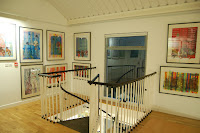It has been a long build up. It was early 2011 when we first mooted the idea of a new exhibitions' space with the South West art community, who confirmed our suspicions that there was a lack of good exhibition venues for hire.
The conversion of the Dutch Barn started in 2013. By 2014 it was complete and we now had a purpose-built, contemporary exhibitions' space making the most of the spectacular light from the floor to ceiling windows and incorporating the very latest gallery lighting and hanging systems.
The inaugural exhibition : 'Metamorphosis' (7 -18 November) featured the work of two South West artists - Dick Hewitson and Maisie Parker who had hired the gallery space.
Dick Hewitson is a Dorset painter, mainly painting in oils, whose interpretations of landscapes range from contemporary figurative to abstract. After initial research in the field, creating rapid sketches in pencil, ink or charcoal, Dick returns to creat the artwork in his studio. He often incorporate charcoal marks into his oil paintings too. Colour is a significant aspect of his work, blending subtle colour mixes for his paintings. You can see more here : http://www.dickhewitson.co.uk/exhibitions.php
 |
| Walking Dorset - Dick Hewitson |
 |
| Maisie Parker |



























